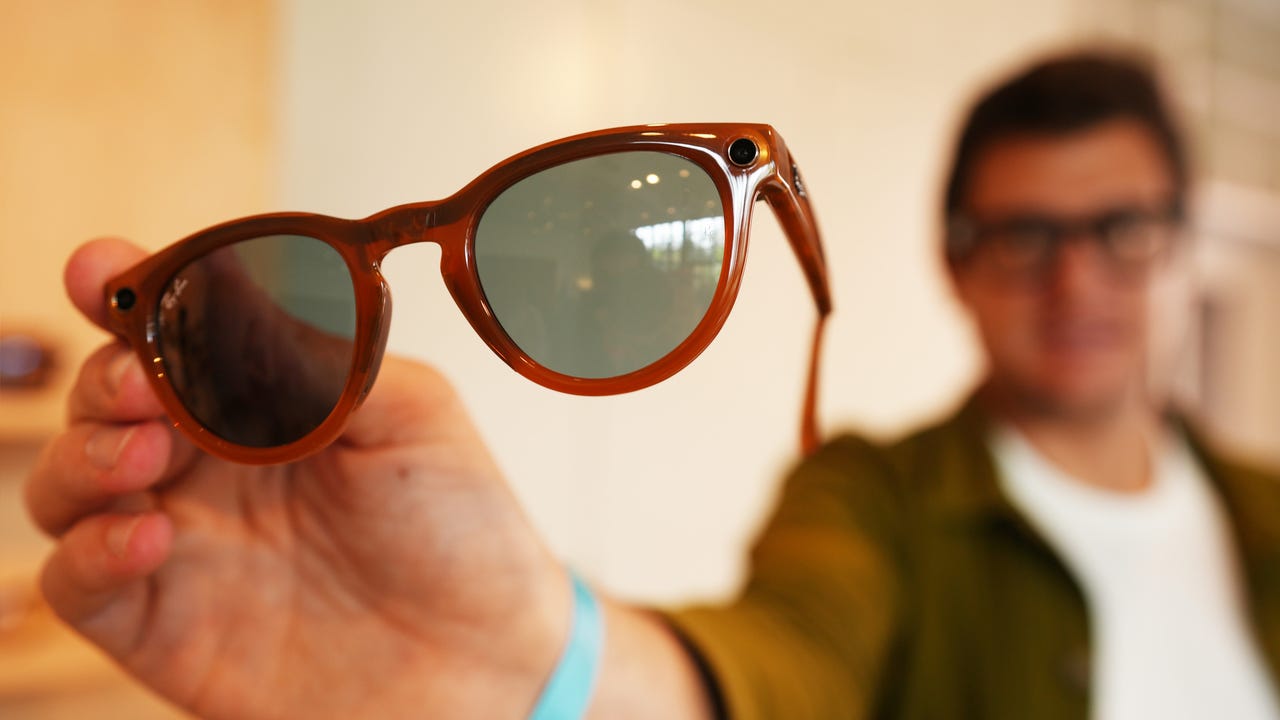
Meta, in partnership with Ray-Ban, is launching a successor to its two-year-old Stories smart glasses, even if the company is shy to admit that the two are related.
The new pair, named Ray-Ban Meta Smart Glasses — note that the Stories label is now missing — is still marketed as an everyday wearable that can capture photos and videos the way your eyes see them. And much like the old version, the smart glasses have built-in speakers and microphones for audio streaming and answers to all the questions you may have for the onboard voice assistant.
Also: Meta Quest 3 hands-on: It’s all about mixed reality with the new VR headset
So, what’s new? Well, it’s more about refining than defining with the latest smart glasses, because if there’s anything that you should know about the predecessor, it’s that while more than 300,000 units were sold over its nearly two-year lifespan, less than 10% of those consumers are still using them. There was plenty of room for improvement.
With that in mind, I spent close to an hour with Meta’s latest wearable ahead of its Connect event today, and I’m happy to report that they’re way better than I expected.
ZDNET RECOMMENDS
Meta Ray-Ban Smart Glasses
The second coming of Meta’s video-capturing glasses offers more styling options, better resolution, and improved speakers at the same $299 price.
View at Meta
I should preface by saying that I wear prescription glasses on a daily basis, a pair from Ray-Ban that looks very similar to Meta’s but minus all the tech smarts. That made my first impression of the Meta glasses one that was curiously familiar. Folks who normally wear sunglasses may and should feel the same way.
Also: These $400 XR glasses gave my MacBook a 120-inch screen to work with
Even with the cameras, speakers, and various modules tucked beneath the frame — all of which were made visible thanks to a new transparent finish that Meta is offering — the smart glasses were very comfortable to wear. Meta tells me it’s not only trimmed down the size and weight of the new wearable by design but also through the use of lighter, more sustainable materials.
Other key improvements include a new 12-megapixel ultra-wide camera that’s capable of capturing sharper photos at 3024 x 4032 pixels and 1080p videos at 1440 x 1920 resolution. Note that both formats are scaled for portrait capturing, as the ideal use case for the glasses is vertical content sharing on Meta’s social platforms, like Facebook and Instagram. That includes live streaming, which you can now start up with a few taps on the wearable.
To assist with this focus on video, Meta has equipped the glasses with five microphones, one of which is cleverly tucked in the nose bridge for the most optimal voice recording. The other mics are scattered across the front and sides of the Ray-Ban and can be used to record 360 audio.
In a private demo, a Meta spokesperson walked around me as he described the new features of the glasses, which made the replay all the more immersive to watch and listen to. I can see the feature being useful if you’re at a family get-together or sports game and want to capture the various sounds coming from all directions.
Also: This thumb-sized camera is my new ‘must-have’ for traveling
Lastly, for the sake of people’s privacy, Meta made the blinking animation of the LED indicator a lot more noticeable when the glasses are recording, which everyone can appreciate.
Customers will be able to configure various aspects of the smart glasses. June Wan/ZDNET
Besides the photo and video capturing aspect, the new Ray-Ban smart glasses are just really nice-sounding Bluetooth headphones. They sound a lot better than the Stories that I tested two years ago, with Meta suggesting that it’s upped the loudness by 50%, and the directional output made it so that those around me were barely able to make out what I was listening to with my volume set to around 60%.
Also: These $350 headphones allowed me to hear things I’d never heard before
Admittedly, I was in a more open studio space with other members of the press being individually briefed, so sound leakage was the least of my worries. As long as you don’t max out the volume when you’re at the library, you’ll be fine.
Before I wrap, I’d like to give a nod to the new charging/carrying case for the smart glasses. It still serves as a wireless charger when the glasses are slotted in, but it’s also significantly slimmer than the previous version, with a leather booklet style instead of the hard-cushioned, snap-on capsule. Meta says it’s 32% lighter than the last model, which I believe, and should give the glasses eight full charges or 32 hours of additional battery life.
ZDNET’s buying advice (for now)
The new Meta Ray-Ban Smart Glasses feel more like traditional eyewear and less like the glasshole-wearing ones in sci-fi movies — even though the functionality is similar. The big question going into ZDNET’s review testing is whether or not Meta has done enough to get my parents, relatives, and non-techie friends to put them on. That would be a major win for a product category that has yet to see a clear breakthrough (and retention) with the mainstream audience.
Also: This ultraportable VR headset gave me a taste of Vision Pro at a fraction of the cost
It’ll certainly help that Meta is offering the new smart glasses through the Ray-Ban remix platform, a customization service that lets users select their frame preference (Wayfarer and Headliner), color (including transparent ones), and lens type (transitions, sun, polarized, clear, and prescription). Depending on how you configure the glasses, the price will vary from its retail of $299.
Featured reviews




















